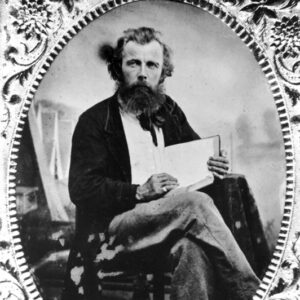calsfoundation@cals.org
Thomas Stevenson Drew (1802–1879)
Third Governor (1844–1849)
Thomas Stevenson Drew was a peddler, schoolteacher, farmer, railroad speculator, and governor of Arkansas. He was the first person to be elected governor by a plurality instead of a majority and the only governor to resign his office because of personal financial difficulties.
Thomas Drew was born in Wilson County, Tennessee, on August 25, 1802. He was the second of ten children born to Newton Drew and Sarah Maxwell Drew. He was raised on a farm and educated in a Tennessee common school. Drew moved to Arkansas in 1817, where he worked as an itinerant peddler and occasionally taught school. In October 1823, he was appointed clerk of the Clark County Court and, three months later, became justice of the peace of Caddo Township.
On February 2, 1827, Drew married Cinderella Bettis; they had five children. Her father, a prosperous landowner, gave the couple 800 acres of land near present-day Biggers (Randolph County). Drew spent the next several years developing this property, and by 1832, he was successful enough to own twenty slaves.
In that year, Drew was elected judge of the Lawrence County Court, a position he held until 1835. In 1836, he was elected to the Arkansas constitutional convention and served on the judiciary committee. For the next eight years, he was active in the Democratic Party, where he maintained the trust of the controlling Johnson-Conway-Sevier political dynasty without alienating its opponents. By the early 1840s, Drew was widely known and influential within party circles, but he had shown no inclination to run for statewide office.
The Democrats were badly split in December 1843 when they met in the party’s first open convention to select nominees for office. It became apparent that the men chosen as candidates for governor and Congress were too weak to face the growing coalition of resurgent Whigs, disgruntled Democrats, and independents. A second convention strengthened the congressional ticket but failed to produce a good gubernatorial candidate. The Democrats, in desperation, returned to the caucus of party leaders to find someone who could unite the badly factionalized party; Drew fit that need exactly. In the 1844 election, Drew, who clearly understood that he had been selected to unite the party, ran as a harmonizer. His opponents attacked him as a nullifier (a supporter of states’ rights) and a nominee who was picked behind closed doors by a clique of powerful men. He carried the state in a close three-way race, but with forty-seven percent of the vote, Drew was Arkansas’s first governor to be elected by a plurality.
As governor, Drew supported a moderate program. He urged the Arkansas General Assembly to create a board of internal improvement with powers to clear rivers and improve the state’s abysmal roads, using the proceeds from the sale of federal lands turned back to the states. He also asked the legislature to establish a state college. On national matters, he endorsed the plan to annex Texas and supported the war with Mexico. Like most Southern leaders, he opposed efforts to ban slavery in the territories.
The major issue that Drew faced in his administration was the restoration of the state’s financial solvency, which had been wrecked by the Panic of 1837. He finally and reluctantly supported a small property tax increase to deal with the state’s debt, but the revenues were too little to restore the credit of Arkansas. The state continued to teeter on the verge of bankruptcy.
Few of Drew’s proposals were adopted by the legislature, but he was well liked by the party faithful. He was easily nominated in 1848 for a second term, and with no formal opposition, he received 15,962 votes out of a total of 16,455 cast in the general election. He was now at the height of his political power and popularity, but the lingering economic crisis and his own speculation in railroads had wrecked his personal finances. Under such circumstances, Drew had been reluctant to run for a second term. He did so with the understanding that his supporters would work to get the governor’s salary raised. When they failed to carry through with the promise, Drew felt betrayed. He resigned from office on January 10, 1849.
He spent much of the next decade trying to rebuild his personal finances. In 1855, he briefly deserted the Democrats to support the Know-Nothing Party. His last race for public office occurred in 1858, when he waged a halfhearted campaign for Congress as an independent Democrat. Drew’s political career was over, and the Civil War destroyed the limited financial recovery he had made in the 1850s. In the early 1870s, he moved to Texas to live with his daughter. He died in Lapin, Texas, in 1879. In 1923, he was re-interred at Pocahontas (Randolph County).
For additional information:
Bolton, Charles S. Arkansas, 1800–1860: Remote and Restless. Fayetteville: University of Arkansas Press, 1998.
Donovan, Timothy P. Willard B. Gatewood Jr., and Jeannie M. Whayne, eds. The Governors of Arkansas: Essays in Political Biography. 2d ed. Fayetteville: University of Arkansas Press, 1995.
Bobby Roberts
Central Arkansas Library System
This entry, originally published in Arkansas Biography: A Collection of Notable Lives, appears in the CALS Encyclopedia of Arkansas in an altered form. Arkansas Biography is available from the University of Arkansas Press.
 Louisiana Purchase through Early Statehood, 1803 through 1860
Louisiana Purchase through Early Statehood, 1803 through 1860 Politics and Government
Politics and Government Thomas Drew
Thomas Drew 




Comments
No comments on this entry yet.